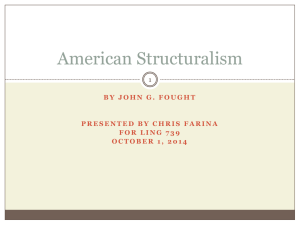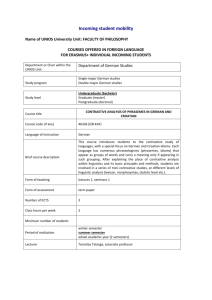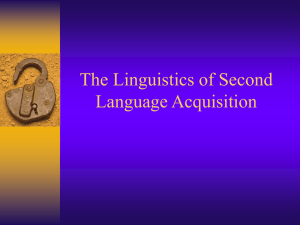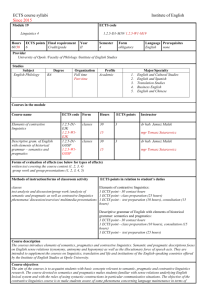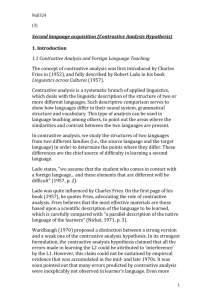Contrastive Analysis in the Classroom
advertisement
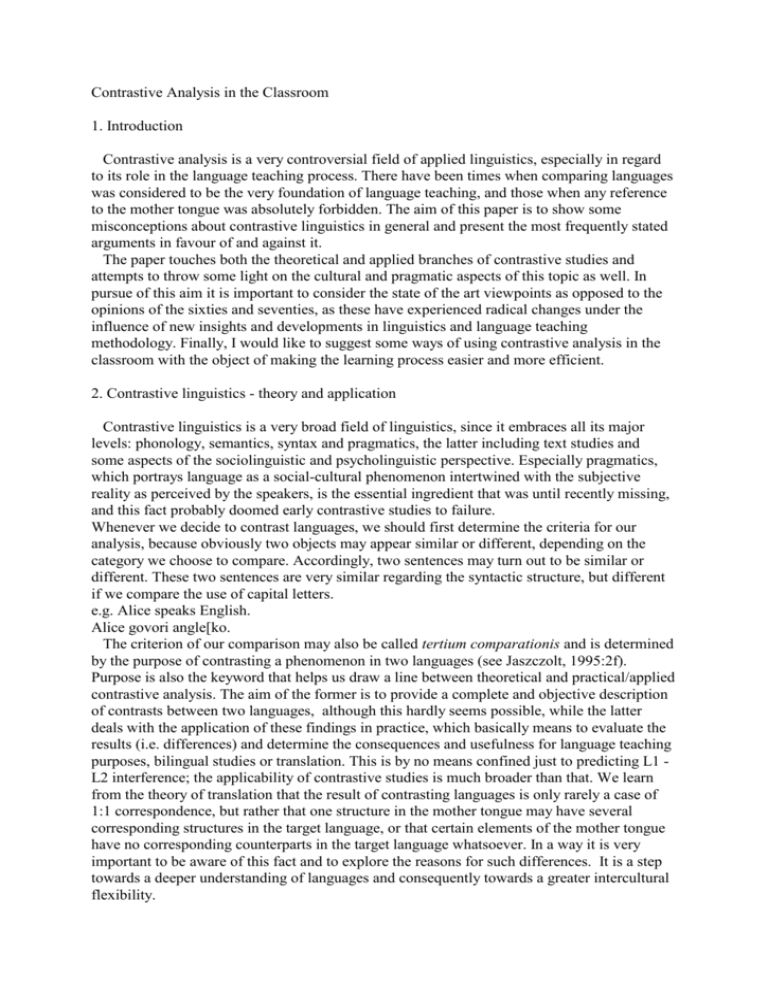
Contrastive Analysis in the Classroom 1. Introduction Contrastive analysis is a very controversial field of applied linguistics, especially in regard to its role in the language teaching process. There have been times when comparing languages was considered to be the very foundation of language teaching, and those when any reference to the mother tongue was absolutely forbidden. The aim of this paper is to show some misconceptions about contrastive linguistics in general and present the most frequently stated arguments in favour of and against it. The paper touches both the theoretical and applied branches of contrastive studies and attempts to throw some light on the cultural and pragmatic aspects of this topic as well. In pursue of this aim it is important to consider the state of the art viewpoints as opposed to the opinions of the sixties and seventies, as these have experienced radical changes under the influence of new insights and developments in linguistics and language teaching methodology. Finally, I would like to suggest some ways of using contrastive analysis in the classroom with the object of making the learning process easier and more efficient. 2. Contrastive linguistics - theory and application Contrastive linguistics is a very broad field of linguistics, since it embraces all its major levels: phonology, semantics, syntax and pragmatics, the latter including text studies and some aspects of the sociolinguistic and psycholinguistic perspective. Especially pragmatics, which portrays language as a social-cultural phenomenon intertwined with the subjective reality as perceived by the speakers, is the essential ingredient that was until recently missing, and this fact probably doomed early contrastive studies to failure. Whenever we decide to contrast languages, we should first determine the criteria for our analysis, because obviously two objects may appear similar or different, depending on the category we choose to compare. Accordingly, two sentences may turn out to be similar or different. These two sentences are very similar regarding the syntactic structure, but different if we compare the use of capital letters. e.g. Alice speaks English. Alice govori angle[ko. The criterion of our comparison may also be called tertium comparationis and is determined by the purpose of contrasting a phenomenon in two languages (see Jaszczolt, 1995:2f). Purpose is also the keyword that helps us draw a line between theoretical and practical/applied contrastive analysis. The aim of the former is to provide a complete and objective description of contrasts between two languages, although this hardly seems possible, while the latter deals with the application of these findings in practice, which basically means to evaluate the results (i.e. differences) and determine the consequences and usefulness for language teaching purposes, bilingual studies or translation. This is by no means confined just to predicting L1 L2 interference; the applicability of contrastive studies is much broader than that. We learn from the theory of translation that the result of contrasting languages is only rarely a case of 1:1 correspondence, but rather that one structure in the mother tongue may have several corresponding structures in the target language, or that certain elements of the mother tongue have no corresponding counterparts in the target language whatsoever. In a way it is very important to be aware of this fact and to explore the reasons for such differences. It is a step towards a deeper understanding of languages and consequently towards a greater intercultural flexibility. 2.1. Levels of analysis As mentioned above, contrastive analysis includes all fields of linguistics such as phonology, semantics, syntax, morphology and pragmatics. It even seems that contrastive studies should rather be regarded as an approach, not as a branch of general linguistics. Most authors tend to distinguish between the so-called microlinguistic and macrolinguistic features, the former comprising mainly the grammatical level and thus treating the sentence as the largest analysable unit, and the latter studying language in situation and context with emphasis on the communicative function. Throughout the history of contrastive studies great attention was paid to grammar and lexicon, whereas the situative and cultural aspects were largely neglected. The following levels of contrastive analysis may already imply their use in language teaching, it must however be noted that no results obtained from a scientifically oriented study are ready for classroom use. My aim here is to list merely some isolated examples, which can by no means present the whole scope of this field. To use the results of contrastive analysis ‘raw’ in the classroom is rather like presenting a customer in a restaurant with the ingredients and a recipe. (Sanders 1981:24) 2.1.1. Phonology The aim of contrastive phonology is to contrast the phonetic sets of both languages and establish the differences. These may lie in the pronunciation of a phoneme that occurs in both languages: e.g. /t/ - Sl. t Engl. th (aspiration) or in the absence of certain phonemes in one of the languages. A further aim is to compare the rules for the position of word-stress, if there are any - Slovene for instance doesn’t have such rules and word-stress must simply be learned individually, which is a great difficulty for the learners of Slovene. Another aspect, which is also to a certain extent linked with pragmatics, is intonation. Intonation, coupled with paraverbal means of communication like mime and gesture, can convey very different meanings and is often the source of misunderstanding between native and non-native speakers of a language. We often forget that in our mother tongue we are used to distinguish between tiny variations in intonation and we readily ascribe meanings to them, whereas in the foreign language the role of intonation and pronunciation in general is largely neglected. In contrasting the set of phonemes of two languages we must inevitably deal with the graphemes as well. In some languages, as in English, a single grapheme may indicate several different phonemes or vice versa (the famous ghoti example by George Bernard Shaw). It is important to contrast this feature with the languages that are strictly grapheme-bound, e.g. Serbian, to a lesser extent Slovene. 2.1.2. Semantics Like most methodological approaches, the communicative approach to language teaching emphasises learning vocabulary items, but the focus is now on the function of vocabulary in the socio-cultural context. In investigating the lexicon of two languages with the object of contrasting them, we are sure to find certain aspects that require special attention. One such field may be the pre- and suffixes used in word-formation. The English suffix -ly that converts adjectives into adverbs roughly corresponds to the Slovene -o, e.g.: obvious-ly oèitn-o happi-ly sreèn-o logical-ly logièn-o There are many examples of such correspondence of affixes: the English suffix -less is often similar to the Slovene prefix brez-: homeless - brezdomec, godless - brezbo\en, careless brezbri\en, timeless - brezèasen etc., the noun suffix -ness can be transposed into Slovene by -oba, -nost: faithfulness - zvestoba, foolishness - neumnost, gratefulness - hvale\nost, foulness - gniloba etc. There are other types of lexical correspondence such as: a piece of furniture - kos pohi[tva, but also of lexical contrast, where some words require a descriptive translation, such as to tap - lahno udarjati, to scan - podrobno pregledati, or call for a paraphrase: typewriter - pisalni stroj. The conclusions to be drawn from such contrasting are summarised by Jaszczolt (1995:4): »The most obvious conclusion is that manuals could aid the learner by providing theoretical descriptions of this phenomenon in the form of a summary and drill, emphasising the difficulty in usage, or any other means available for that particular LT method. There are also more theoretical conclusions to be drawn, namely that there is no clear-cut distinction between contrastive lexicology, morphology and syntax: linguistic patterns are handled between the three in the contrastive perspective.« There is another area where contrastive studies are of particular use, namely lexicography and the theory of lexicography. An interesting issue in this field is the study of universals, i.e. of concepts that do not differ across cultures and are shared by many different language systems. Unfortunately, the limits of this paper do not allow me to deal with these issues in more detail. 2.1.3. Syntax In contrasting the syntactic structures of two languages as different as Slovene and English, the former being case-based and the latter word-order-based, we inevitably encounter so many differences that an analysis without our having a particular purpose in mind hardly seems reasonable. The position of complements in an English sentence is fixed, but not so in Slovene, since grammatical relations can be expressed through the use of inflections, which accounts for many structural differences between the two languages: eg. Njegovega oèeta \e dolgo nisem videl. *His father for a long time I haven’t seen. but possible in German: Seinen Vater habe ich schon lange nicht gesehen. The example above is therefore not of much interest regarding the position of the subject and the direct object, but lends itself to further analysis as far as the position of the adverbial phrase is concerned. But there is another aspect of sentence structure that occurs in great variations across languages and should thus be compared, namely the order of elements according to their importance. Nearly all languages of the world can in some way or other make an item of information stand out in a sentence. Most European languages use sentence structure as one of the tools for doing that. Some other ways are introductory or emphatic subjects and objects, emphatic adjectives and adverbs and of course intonation. The rules for the position of information items, for example new information at the end of the sentence, are quite firm and are intuitively obeyed by most speakers, even by non-natives. Still, this is an interesting area in which syntax and pragmatics overlap. 2.1.4.Text analysis and pragmatics There is more to languages than grammar and words. If we are to master a language, we must not only know how to form phrases and sentences, but also how to form texts. This branch of linguistics is often referred to as discourse or register analysis and presents a rather new area of interest, at least compared to other levels of describing language (semantics, syntax etc.). This may seem surprising, as it is quite obvious that as there are rules for putting words together to form a sentence, there must be some kinds of rules for putting sentences together to form a text. If we randomly put ten sentences together, the odds that they will make a coherent and meaningful text are rather small. The problem is that the rules for forming texts are not as explicit as grammatical rules, and they nearly always imply certain metatextual factors, for example the situative context, cultural setting, the intentions of the speaker/writer and the expectations of the listener/reader, and many more. The task of contrastive text analysis and contrastive pragmatics is to compare these »rules« and factors and establish the differences, which can help learners of a language to communicate more efficiently. A simple example can be taken from set textual patterns like the formal letter. The outline of a formal letter is a social convention that varies from country to country, but the differences between, say, English, German and Slovene formal letters are rather small. Still, the function of the formal letter is usually to convey important information and, usually, to make a good impression. If the simple rules for writing formal letters are disobeyed, if we for instance use the wrong form of address, the effect on the reader may be disturbing and the consequences unpleasant. The mechanisms that generate meaning between sentences are complex and the rules for text composition very vague, but this is the very reason why we need to study them and compare them across languages. Viewed from this angle, contrastive text analysis and pragmatics may well be the most important levels of contrastive linguistics, especially with regard to language teaching. 3. Ways of using contrastive analysis in the classroom Contrastive analysis in the classroom usually implies certain methods and strategies that are notoriously »forbidden«, such as the use of the mother tongue and translation. My view of this approach, and it seems appropriate to call it an approach, is broader than this: contrastive analysis refers to all previous language experience of the learner and is a natural process in every learning situation. According to this view it is not only the native language of the learner that is a very powerful factor in foreign language learning, but rather all languages and language situations that the learner has ever encountered. Especially in trying to understand a new grammatical or lexical element, the learner would scan all his previous knowledge in order to find similarities (see Skela 1994:78). Try as we would, this »habit« cannot be eliminated from the process of learning, so perhaps it is time to find ways of using it to our and the learner’s advantage. In other words (Marton 1981:149): »The question then suggests itself whether it isn’t better to use this habitual transfer in some way rather than desperately trying to fight it and eradicate it, or even to deny its existence. I think that using contrastive analysis in the classroom would go a long way towards controlling this powerful tendency and making an ally of what has long been considered our greatest enemy. If we now agree that contrastive analysis can and should be used in the classroom, several questions come to mind: When do we choose to compare a certain language item to the mother tongue or to another foreign language already mastered by the students? Which segments of language lend themselves to comparison or contrasting? Should we concentrate on the similarities or the differences? Can this approach be used in all age groups and levels? What purpose do we have in mind and what results can we expect from using contrastive analysis? Perhaps these questions should be dealt with one at a time. As for the general decision about when to compare or contrast a certain language item, the only possible answer is: whenever we feel it appropriate. Once again, the teacher should rely on his/her own resourcefulness and follow the eclectic approach. If we take Slovene learners of English, there are many grammatical structures and phrases that are conspicuously different from Slovene, but does that mean that we should point out all the differences we encounter on the way? This brings us to the field of error analysis. In the seventies experts believed to have found the ultimate key to predicting and explaining errors - contrastive analysis. Still, years of experience have shown that negative transfer is by no means the only source of errors and that the use of contrastive analysis in the classroom failed to bring the expected results. So disappointing was this fact that experts decided to ban contrastive studies from the classroom altogether, which accounts for their neglected status in the past two decades. Perhaps the best strategy is to »wait« for a certain error to occur, and then - if the reason was indeed negative transfer - point out the difference and illustrate it with examples. Negation of English sentences is often a source of errors for Slovene learners, because English syntax doesn’t allow double negation, which is a common grammatical feature in Slovene. e.g. Nikogar ne poznam v tej vasi. *I don’t know nobody in this village. Nikoli ni nikomur nièesar dal. *He has never given nobody nothing. Another example of negative transfer often occurs with Slovene learners of German who already master English. The German modal verb wollen corresponds to the English verb want, but the 1st person singular form Ich will... is often misinterpreted as future tense because of the English structure I will... . Students thus have to be reminded that future tense in German is formed with the verb werden: Ich werde nach Hause gehen for I will go home. As for the question whether to concentrate on the similarities or differences between two languages, there is no universal answer. If there is a similarity between the mother tongue and the foreign language, we usually need not point it out, because the students will intuitively sense it. What we do need to point out are the cases where the apparent similarity is misleading, as is the case with false friends: sympathetic vs. simpatièen, local vs. lokal, etc. Here it should again be noted that two items of language may appear similar or different, according to the criteria and purpose of our comparing/contrasting them. If we take conditional clauses in Slovene and English, the overall structure is rather similar, but the tenses are different (Mikliè 1994:91): e.g. Èe bo lepo vreme, bomo [li ven. If the weather is fine we’ll go out. The question whether contrastive analysis could or should be used at all levels and for all age groups remains under-researched. Since I wasn’t able to find any clear guidelines regarding this decision, I can merely state some of my personal observations from my teaching experience. It seems that both age and level of language knowledge are very important factors for deciding whether to provide the learners with some contrastive examples or not. With very young learners the teacher often uses the mother tongue, provided that he or she speaks it and that it is a monolingual classroom. Still, any contrasting of grammatical structures would be out of place, because the learners have not yet reached the level of abstract thinking. Some simple techniques of translation, and translation is considered to be one of contrastive techniques, may however be used successfully also at this level, but moderately. As soon as the learners have reached the level of abstract thinking and are able of conscious generalisation of grammatical rules, contrastive analysis may be used to point out certain conspicuous differences or explain mistakes. Learners sometimes even demand a contrastive explanation, especially when there is a clash between the first foreign language and the second foreign language, for example Slovene learners of German who have already learned English. It seems that negative transfer occurs even more often between L2 and L3 that between L1 and L2. A possible explanation for this phenomenon is the fact that the mother tongue is acquired subconsciously and the grammatical rules are internalised. Acquiring the mother tongue is an experience quite different from foreign language learning, which could be the reason why the rules of the mother tongue do not interfere with the foreign language as often as might be expected. The experience of the first foreign language learning however determines all further foreign language learning, and learners tend to apply rules acquired through the first experience to all language learning experiences that follow. Generally speaking, contrasting grammatical features makes the most sense with those learners who already have some experience with foreign language learning and are thus already used to comparing languages and language items. Most contrastive techniques are not appropriate for very young learners and elementary stages. The rest is basically a matter of personal taste and experience - if the teacher believes contrastive analysis to be useful, he or she will undoubtedly find ways of using it. A detailed study of existing contrastive techniques unfortunately cannot be included in this paper. Here I briefly mention some: contrasting grammatical or lexical items during the presentation, contrasting idioms, proverbs, set phrases etc., translation, contrastive pragmatics. This is a very broad field, which does not necessarily include any specific language item, but rather focuses on the basic social and cultural conventions that rule communication in a certain context or situation. Some very important skills should be taught here, which often have nothing to do with language but with non-verbal means of communication. What is the typical head movement indicating agreement or disagreement? Do we shake hands when introduced to somebody? Which interjection do we use to express disgust and what facial expression goes with it? Of course a foreign language can be taught and learned without referring to the mother tongue (or L2). But if some of these techniques can facilitate learning or even make it more interesting, why not use them. 4. Conclusion These are but a few aspects of contrastive analysis and its possible uses in the classroom. The reason why I am in favour of occasional contrasting of languages is not just the fact that it may help to predict, explain or prevent mistakes, but rather that it provides a different and long-neglected insight into how languages work and how we can understand and consequently remember their features better. As Nation points out (1978:175): »It is worth mentioning two other possible effects. Exclusion of the mother tongue is often seen by the learners as a criticism of the mother tongue as a language, thus making it seem like ‘a second-grade language’. The effects of this degrading of the mother tongue are not beneficial to the mother tongue nor to the people who use it. Secondly, learning a foreign or second language provides an opportunity for learning about the nature of language, how a language works, how different languages organise the world and experience in different ways. Comparison between the mother tongue and the foreign language is a good way of doing this.« Much research remains to be done in this field, and if the most popular concept of language teaching methodology in the nineties is ‘intercultural aspects’, we should not forget that language, too, is part of the culture, and comparing languages thus belongs to intercultural studies. 5. Bibliography Breitenstein, P.H. (1978) The Application of Contrastive Linguistics. ELT Journal, 33/1:2126. Duff, A. (1989) Translation. Oxford: Oxford University Press. Jaszczolt, K. (1995) Typology of Contrastive Studies: Specialisation, Progress and Applications. Language Teaching 28/1995: 1-14. Cambridge: Cambridge University Press. Lightbown, P. and Spada, N. (1993) How Languages are Learned. Oxford: Oxford University Press. Marton, W. (1981) Contrastive Analysis in the Classroom. J. Fisiak (ed.): Contrastive Linguistics and the Language Teacher. Oxford: Pergamon Press. Mikliè, T. (1994) Eksplicitno kontrastiranje principov ubesedovanja logièno semantiènih relacij pri pouku tujega jezika: problemi izra\anja pogojenosti v razliènih jezikih. Uporabno jezikoslovje (Applied Linguistics), 3/1994, Ljubljana. Nation, I.S.P. (1978) Translation and the Teaching of Meaning: Some Techniques. ELT Journal 32/1: 171-175. Sanders, C. (1981) Recent Developments in Contrastive Analysis and Their Relevance to Language Teaching. J. Fisiak (ed.): Contrastive Linguistics and the Language Learner. Oxford: Pergamon Press. Skela, J. (1994) Materin[èina v uèenju in pouèevanju tujega jezika: zmota, potreba ali pravica? Uporabno jezikoslovje (Applied Linguistics), 3/1994, Ljubljana.
